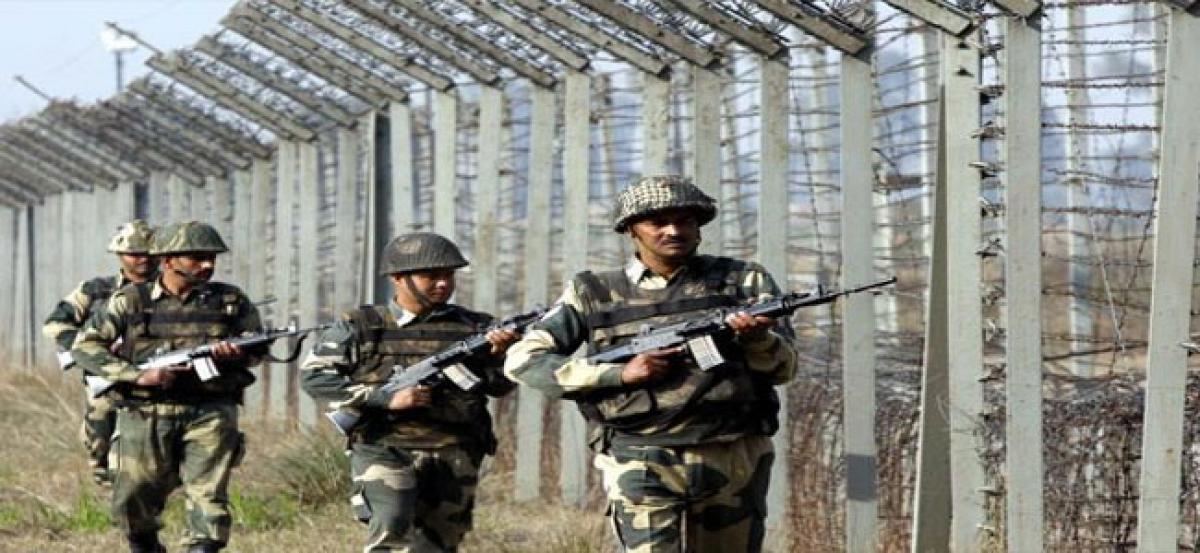India – Myanmar Border Management

India shares a 1643 km long border with Myanmar, of which 171 km is not demarcated. The northeast states of Arunachal Pradesh, Nagaland, Manipur and Mizoram share the border with Myanmar.Terrain on the Indo-Myanmar border is semi mountainous with steep slopes covered with dense forest, perennial and seasonal rivers and nullahs with numerous waterfalls.
India shares a 1643 km long border with Myanmar, of which 171 km is not demarcated. The northeast states of Arunachal Pradesh, Nagaland, Manipur and Mizoram share the border with Myanmar.
Terrain on the Indo-Myanmar border is semi mountainous with steep slopes covered with dense forest, perennial and seasonal rivers and nullahs with numerous waterfalls.
Cross-country movement is extremely difficult and is restricted to existing tracks only. Thick vegetation restricts both ground and aerial observation. Small villages in the border areas have tribal population, who share affinity with population in Myanmar.
This border is manned jointly by the army and Assam Rifles which has 46 battalions guarding the border. Cross-border ethnic ties have facilitated in creation of safe havens for various northeast insurgent groups in Myanmar.
Border fencing works and flood lighting have started. The diversion of AR for counter insurgency (31) and border guarding (15) has resulted in poor management of borders and also frequent clashes with the local population.
Myanmar is important to India due to historical, ethnic and cultural ties. Myanmar is of great strategic importance as it is a gateway to South East Asia and holds huge economic potential for India.
Myanmar also provides China a route to the second coastline into the Arabian Sea from Kunming through the Sittwe port. The border as well as the Arakan coast can become vulnerable for India due to increasing Chinese economic ties with Myanmar.
China has already made huge investments in Myanmar in terms of infrastructure development and construction of pipelines for purchase of oil and natural gas. India needs to engage Myanmar as it is important for the development of the North eastern region of India.
Challeneges
- he border with Myanmar also remains operationally active.
- Several insurgent groups have secured sanctuaries for themselves in Myanmar.
- The cross border movement of Nagas and Mizos for training, purchase of arms and shelter when pursued by Indian security forces, combined with the difficult terrain obtaining in the area makes this border extremely challenging to manage.
- Identical tribes live on both sides of the boundary pose difficulty in restricting the movement of the people.
- Apart from that the border area is vulnerable due to the narco-terrorism, smuggling of arms and fake Indian currencies compared to other borders.
- The Intelligence inputs indicate that a major modernization drive of the Chinese Army has released vast quantities of old weapons, some of them are offloaded to the arm dealers who supply it to the insurgent groups.
- Security concerns along Indo-Myanmar Border need to be viewed holistically, particularly with reference to the influence and physical presence of China in socio-economic and military affairs of Myanmar.
- The junction of India, Bangladesh and Myanmar is also vulnerable due to the Chakma problem and frequent infiltration of Muslims from Myanmar to Bangladesh
India – Nepal Border Management
- Indo-Nepal border is 1751 km long with Uttarakand, Uttar Pradesh, Bihar, West Bengal and Sikkim.
- It is an open border The border with Nepal was virtually un-attended till very recently as Nepalese citizens have free access to live and work in India under a 1950 treaty between the two countries. Since the eruption of a Maoist insurgency in Nepal efforts have been made to gradually step up vigilance along this border as India fears the southward spreads of Maoist ideology.
- The responsibility for this has been entrusted to the Sashastra Seema Bal (SSB) which has 27 battalions guarding the border.
- India has increased the border patrolling and also CBM with Nepali counterparts. The major challenges faced due to a porous border are of illegal immigration for economic reasons, smuggling and terrorism.
India – Bhutan Border Management
- The Indo-Bhutan border is 699 km long sharing with Sikkim, Arunachal Pradesh, Assam and West Bengal.
- It is a closed border which has been manned by SSB’s with strength of 13 battalions.
- It is relatively peaceful and effectively coordinated guarding with the cooperation of Bhutanese counterparts.
- For the Bhutan border, the BSF shares the responsibility with the SSB.
- Since the Royal Bhutanese Army drove out the Bodo and ULFA insurgents from its territory some years ago, the border has been relatively quiet, but there is need to ensure that such groups do not again create sanctuaries for themselves in Bhutan.
Areas of Concern
Policy On Border Management
India does not have a border policy or a national security policy. The National Security Advisory Board (NSAB) has formulated the Draft National Security Policy, which is still under consideration. Though the Department of Border Management was created under the Ministry of Home Affairs in 2004, the critical issues of command and control have not been resolved even after twelve years.
India does not have policies and systems in place along with multiple ministries working on border issues. This has led to chaos and competition on the field among different agencies.
Multiple Stakeholders
- MEA is responsible for the demarcation of the international borders; whereas MHA is given the responsibility to manage borders. MEA is hampered due to low staffing levels and does not enjoy much leverage with state governments due to limited interaction.
- Also, army under the MoD is responsible for border defence; it is not responsible for guarding the border except in J&K. Given multiple ministries and large number of border guarding agencies, there are competing and multiple instructions trickling down leading to a lot of confusion on field.
- Border management does not just include guarding, defending and managing the borders but it also includes the local people, trade, growth and development of the region.
- There is a subtle difference between border guarding and border defence and border management. While border guarding is a policing task, border defence as the name indicates is a security task and management is an all-encompassing task.
- The management policies should be laid down clearly and should be the responsibility of the MHA.
Border Dispute Resolution
- The Indian approach in resolving border disputes should be changed.
- The Parliament resolution which decrees to take back every square inch of land under illegal occupation, whether in Pakistan Occupied Kashmir or China is hampering in resolving disputes.
- As long as India has this resolution, no political party will have the will and motivation to work out a compromise.
- It is important for the government to work out a compromise in its boundary issues. Also, a dedicated department is needed for resolving border issues.
- India and Pakistan has to evolve a mechanism for a peaceful coexistence. Though several secretary level talks and track II diplomacy initiatives have been held, they have had limited impact on improving the relations.
- Pakistan Army’s over-reaching influence is the main stumbling block in lowering of tensions along the Indo-Pakistan border.
Increased trade and strengthening of democratic structures may have desired impact due to prevailing security and economic conditions.
Indo-China Boundary
- The Indo-China boundary dispute has been unresolved due to differing perceptions and claim lines.
- China has resolved its boundary issues with all countries except India and Bhutan. Shortcomings in understanding the nuances of the border with China by different agencies are a challenge.
- All stakeholders, MEA, MHA, Indian Army, ITBP need to have a single thought process. Each agency has different perceptions and at times differing maps marked with differing claim lines, whereas the Chinese authorities have always presented a single view.
- The length of border needs to be clearly articulated and quoted as such in all interactions by all stakeholders. There is a requirement of having a special cell to look border issues. It has been often noticed that the same Chinese interlocutors have been part of various committees for long periods of time.
Different Borders need Different Approaches
The countries which shares borders with India require different border management. There are three types of borders. They are:
- Hostile enemy
- Benign state
- Benign state and benign border
- Each of these borders requires a different policy orientation and policy instinct.
- In the context of India, the Indo-Pak and Indo-China border can be categorized as an aggressive border.
- However, armed infiltration is taking place from Pakistan but not from China.
- At the same time the Myanmar border is a benign border for India. Historically it has acted as a buffer between India and China.
Border Management Policy
- India needs to formulate and promulgate its policy on border management. The policy must enunciate clear cut response mechanisms and issues of command and control.
- The border management policy must take into account the peculiarities of each border and evolves a comprehensive strategy to amalgamate all available resources for effective border management.
- The management of disputed and unresolved border must be the responsibility of Indian Army functioning under the MoD.
- The management of other borders must be with the CAPFs, functioning under MHA. All the organizations should seek directions and be accountable to one nodal agency during peace and war.
- In event of more than one force on a particular border, the chain of command must be clearly laid down.
Nodal Ministry
The nodal ministry for management of unresolved and disputed should be MoD. Other borders must be managed by MHA.
Restructuring Of Border Guarding Forces
The border guarding responsibility should be changed according to the nature of security threat and on the basis of specialization of guarding force. It is suggested that the Indian Army should be given the responsibility to manage all unresolved and disputed borders like AGPL, LoC, LAC.
Involvement Of Stakeholders
- Stakeholders in border areas are the people living in border areas, the State administration, border guarding forces and Central agencies involved in border development. Little coordination exists between them.
- Therefore, it is suggested that the development effort in border areas must be done taking all stakeholders on board. State governments must be actively involved in the process of finding solutions to the border issues.
- The area of responsibility for conduct of operations between the State Police and the border guarding force must be institutionalized to do away with local arrangements.
Technology
- Technology should also be infused into border guarding along with the present system of man power, taking into account the perceived threat, terrain and local population sensitivities.
- Use of state of art technology for border surveillance. Drones should form a major part of the surveillance effort in difficult and sparsely populated areas. Modern C4I2SR capabilities need to be employed to cover gaps, particularly in remote/ inaccessible areas, and to supplement human surveillance and patrolling.
- Use of GIS and digitization of maps.
- Formation of technology committee to oversee quick procurement and implementation.
Expected Questions
How does illegal trans-border migration pose a threat to India’s security? Discuss the strategies to curb this, bringing out the factors which give impetus to such migration.
How far are India’s internal security challenges linked with border management particularly in view of the long porous borders with most countries of South Asia and Myanmar?
By Gudipati Rajendra Kumar




















